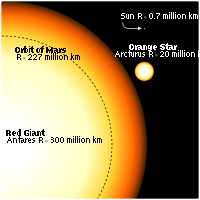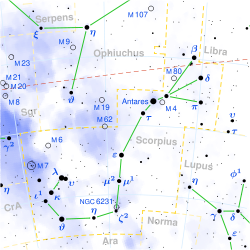- Antares
-
Antares A/B Observation data
Epoch J2000 Equinox J2000Constellation Scorpius Right ascension 16h 29m 24s[1] Declination -26° 25′ 55″[1] Apparent magnitude (V) +1.09[1] Characteristics Spectral type M1.5Iab-b / B2.5V[1] U−B color index 1.34 B−V color index 1.87 Variable type LC[2] Astrometry Radial velocity (Rv) −3.4 ±0.9[1] km/s Proper motion (μ) RA: −10.16 ±2.03[1] mas/yr
Dec.: −23.21 ±1.29[1] mas/yrParallax (π) 5.40 ± 1.68[1] mas Distance approx. 600 ly
(approx. 190 pc)Absolute magnitude (MV) −5.28 Details Mass 15.5 / 10 M☉ Radius 800 / 4 R☉ Luminosity 65,000(bolometric) L☉ Temperature 3,500 K Other designations Database references SIMBAD data Antares (α Scorpii, α Sco, Alpha Scorpii) is a red supergiant star in the Milky Way galaxy and the sixteenth brightest star in the nighttime sky (sometimes listed as 15th brightest, if the two brighter components of the Capella quadruple star system are counted as one star). Along with Aldebaran, Spica, and Regulus it is one of the four brightest stars near the ecliptic. Antares is a slow variable star with an average magnitude of +1.09.[1]
Contents
Properties
 Comparison between the red supergiant Antares and the Sun, shown as the tiny dot toward the upper right. The black circle is the size of the orbit of Mars. Arcturus is also included in the picture for size comparison.
Comparison between the red supergiant Antares and the Sun, shown as the tiny dot toward the upper right. The black circle is the size of the orbit of Mars. Arcturus is also included in the picture for size comparison.
Antares is a class M supergiant star, with a radius of approximately 800 times that of the sun; if it were placed in the center of our solar system, its outer surface would lie between the orbits of Mars and Jupiter. Antares is approximately 600 light-years (180 pc) from our solar system. Its visual luminosity is about 10,000 times that of the Sun, but because the star radiates a considerable part of its energy in the infrared part of the spectrum, the bolometric luminosity equals roughly 65,000 times that of the Sun. The mass of the star is calculated to be 15 to 18 solar masses.[3] Its large size and relatively small mass give Antares a very low average density.
The size of Antares may be calculated using its parallax and angular diameter. The parallax angle is given in the box to the right, and the angular diameter is known from lunar occultation measurements (41.3 ± 0.1 mas).[4] This leads to a radius of 822 ± 80 solar radii.[clarification needed]
Antares is a type LC slow irregular variable star, whose apparent magnitude slowly varies from +0.88 to +1.16.[2]
The best time to view Antares is on or around May 31 of each year, when the star is at opposition to the Sun. At this time, Antares rises at dusk and sets at dawn, and is thus in view all night. For approximately two to three weeks on either side of November 30, Antares is not visible at all, being lost in the Sun's glare; this period of invisibility is longer in the Northern Hemisphere than in the Southern Hemisphere, since the star's declination is significantly south of the celestial equator.
Companion star
Antares has a hot blue companion star, Antares B, of spectral type B2.5 at a separation of about 2.9 arcseconds, or 550 AUs at Antares' estimated distance.[3] At magnitude 5.5, it is only 1/370th as bright visually as Antares A, although it shines with 170 times the Sun's luminosity. It is normally difficult to see in small telescopes due to Antares' glare, but can sometimes be seen in apertures over 150 mm (5.9 in).[5] The companion is often described as green, but this is probably a contrast effect.[3] Antares B can be observed with a small telescope for a few seconds during lunar occultations while Antares itself is hidden by the Moon; it was discovered by Johann Tobias Bürg during one such occultation on April 13, 1819.[6]
The orbit is poorly known, with an estimated period of 878 years.
Position on the ecliptic
Antares is one of the 4 first magnitude stars that lies within 5° of the ecliptic and therefore can be occulted by the Moon and rarely by the planets. On 31 July 2009, Antares was occulted by the moon. The event was visible in much of southern Asia and the Middle East.[7][8] Every year around December 2 the Sun passes 5° north of Antares.
Traditional names
Antares, the proper name of this star, derives from the Ancient Greek Άντάρης, meaning "(holds) against Ares (Mars)", due to the similarity of its reddish hue to the appearance of the planet Mars. It is the brightest star in the constellation Scorpius. However, it is also thought[clarification needed] that Antares may have been named after the ancient Arab warrior-poet Antar.[9] Its distinctive color has made the star an object of interest to many societies throughout history.
- In Persia, Antares was known as Satevis, one of the four "royal stars".[10]
- In India, it with σ and τ Sco were one of nakshatra (Hindu lunar mansion), as Jyeshthā "Oldest", and Rohinī "Ruddy".[9]
- In China, it was named 心宿二 (Mandarin: xīn sù èr), because it was the second star of the asterism 心宿 ("Heart").
- Antares is listed in MUL.APIN as GABA GIR.TAB, meaning "the Breast of the Scorpion:Lishi, Nabu".[11]
- In Renaissance astrology, Antares is one of the Behenian fixed stars and has the symbol
 .[12]
.[12] - The Wotjobaluk Koori people of Victoria, Australia, knew Antares as Djuit, son of Marpean-kurrk (Arcturus); the stars on each side represented his wives. The Kulin Kooris saw Antares (Balayang) as the brother of Bunjil (Altair).[13]
Alternative name of this star, meaning "the Heart of Scorpion":
- Calbalakrab from the Arabic Qalb al-Άqrab.[14] This had been directly translated from the Ancient Greek Καρδία Σκορπίου Kardia Skorpiū.
- Cor Scorpii translated above Greek name into Latin.[9]
See also
References
- ^ a b c d e f g h i j k l m n o p q r "SIMBAD Astronomical Database". Results for CCDM J16294-2626A/B. http://simbad.u-strasbg.fr/Simbad. Retrieved 2006-10-23.
- ^ a b "Query= alf Sco". General Catalogue of Variable Stars. Centre de Données astronomiques de Strasbourg. http://www.sai.msu.su/gcvs/cgi-bin/search.cgi?search=alf+Sco. Retrieved 2010-01-05.
- ^ a b c Kaler, James. "Antares". http://www.astro.uiuc.edu/~kaler/sow/antares.html. Retrieved 13 August 2008.
- ^ A. Richichi (April 1990). "A new accurate determination of the angular diameter of Antares". Astronomy and Astrophysics 230 (2): 355–362. Bibcode 1990A&A...230..355R.
- ^ Schaaf, Fred (2008). The Brightest Stars: Discovering the Universe Through the Sky's Most Brilliant Stars. John Wiley and Sons. p. 218. ISBN 9780471704102. http://books.google.com/?id=LvnNFyPAQyUC&pg=PA218&lpg=PA218.
- ^ Burnham, Robert, Jr. (1978). Burnham's Celestial Handbook. New York: Dover Publications. p. 1666.
- ^ "Occultation of Antares on 31 July 09". The International Occultation Timing Association. http://www.lunar-occultations.com/iota/bstar/0731antares.htm. Retrieved 2 August 2009.[dead link]
- ^ "Sky watchers report occultation of Antares by moon". The Times Of India. 2 August 2009. http://timesofindia.indiatimes.com/NEWS/City/Pune/Sky-watchers-report-occultation-of-Antares-by-moon/articleshow/4846671.cms.
- ^ a b c Allen, R. H. (1963). Star Names: Their Lore and Meaning (Reprint ed.). New York, NY: Dover Publications Inc.. pp. 364–366. ISBN 0486210790.
- ^ Allen, R. H. (1963): According to Charles François Dupuis, a French astronomical writer
- ^ Rogers, J. H. (February 1998). "Origins of the ancient constellations: I. The Mesopotamian traditions". Journal of the British Astronomical Association, no.1 108: 9–28. Bibcode 1998JBAA..108....9R.
- ^ Hermes Trismegistus on the Fifteen Fixed Stars features alternate symbols.
- ^ Mudrooroo (1994). Aboriginal mythology : an A-Z spanning the history of aboriginal mythology from the earliest legends to the present day. London: HarperCollins. p. 5. ISBN 1855383063.
- ^ Kunitzsch, P. (1959). Arabische Sternnamen in Europa. Wiesbaden: Otto Hrrasowitz. p. 169.
External links
- A comparison of the size of Antares to other celestial objects
- Exploring the Full Stellar Population of the upper Scorpius OB Association
- Antares on WikiSky: DSS2, SDSS, GALEX, IRAS, Hydrogen α, X-Ray, Astrophoto, Sky Map, Articles and images
Coordinates:
 16h 29m 24s, −26° 25′ 55″
16h 29m 24s, −26° 25′ 55″Bayer α (Antares) • β (Graffias) • δ (Dschubba) • ε • ζ¹ • ζ² • η • θ (Sargas) • ι¹ • ι² • κ (Girtab) • λ (Shaula) • μ¹ (Denebakrab) • μ² • ν (Jabbah) • ξ • ο • π • ρ • σ (Al Niyat) • τ (Alniyat) • υ (Lesath) • χ • ψ • ω¹ • ω² • b • c¹ • c² • d • i • k • A • G (γ Tel) • QFlamsteed 1 (b) • 2 (A) • 3 • 4 • 5 (ρ) • 6 (π) • 7 (δ, Dschubba) • 8 (β, Graffias) • 9 (ω¹) • 10 (ω²) • 11 • 12 (c¹) • 13 (c²) • 14 (ν, Jabbah) • 15 (ψ) • 16 • 17 (χ) • 18 • 19 (ο) • 20 (σ, Al Niyat) • 21 (α, Antares) • 22 (i) • 23 (τ, Alniyat) • 25 • 26 (ε) • 27 • 34 (υ, Lesath) • 35 (λ, Shaula) • 51 Lib (ξ) • 61 Nor • 62 Nor • 64 NorNearby Other Categories:- Bayer objects
- Flamsteed objects
- Binary stars
- B-type main sequence stars
- M-type supergiants
- Scorpius constellation
- Stars with proper names
- Irregular variables
Wikimedia Foundation. 2010.

